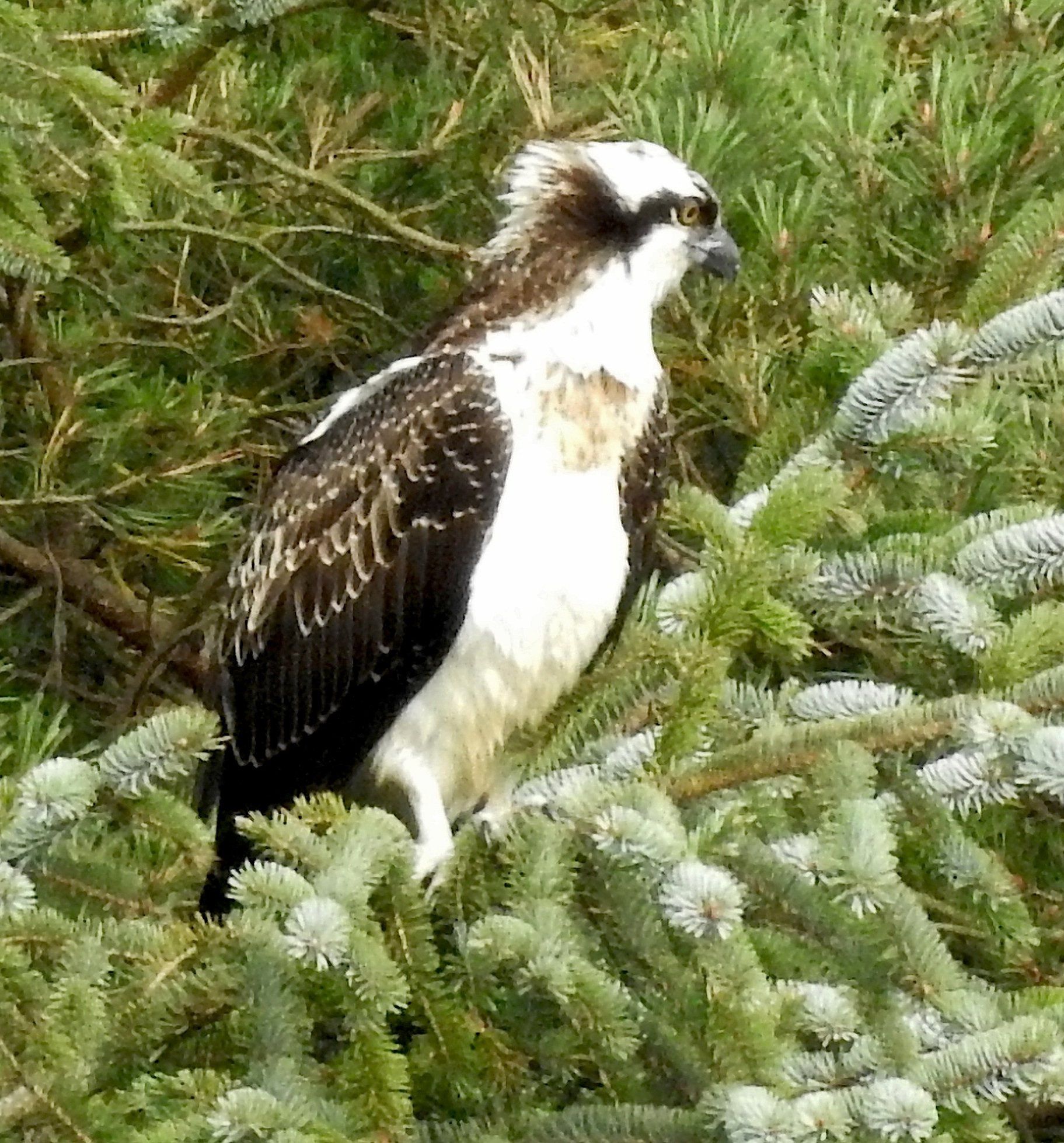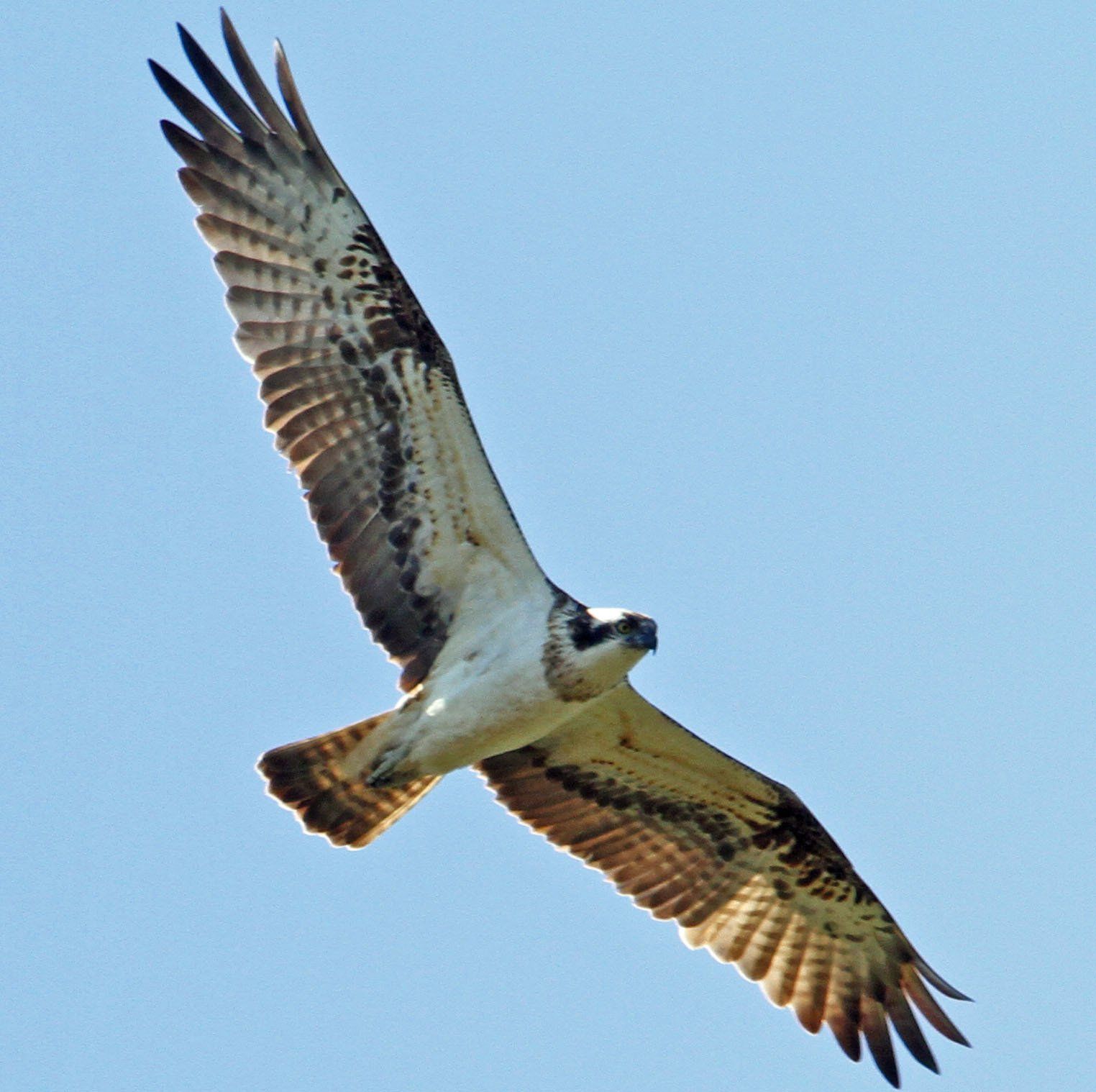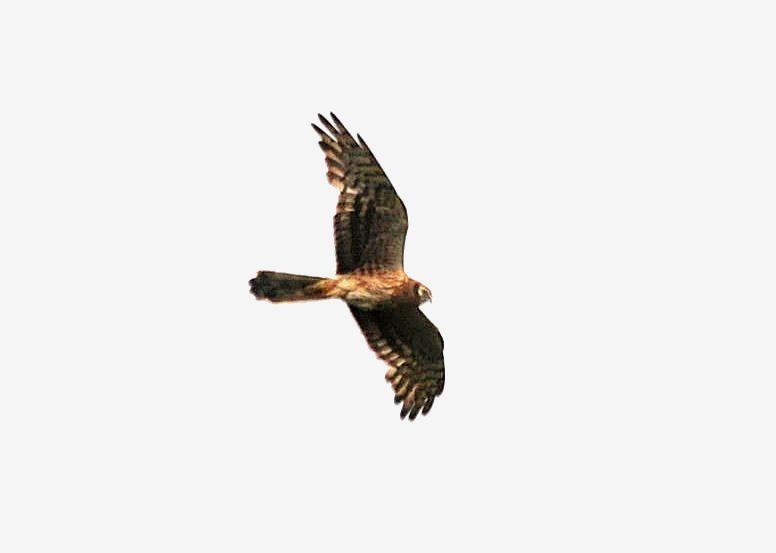OSPREY
Pandion haliaetus
Uncommon but regular passage visitor. History of Osprey in the Bradford Ornithological Group area 1990 - 2018
2016
- Sixteen records of at least that number of birds represents the best return in 10 years, and all parts of the area participated.
Spring passage produced two thirds of the records, starting with birds at Barden Scale on 25th and 26th March, followed by at least one in the area on 3rd April, and another 10 days later. This period was particularly productive, as three presumably different birds were seen on the 4th, over Hazlewood Moor, Queensbury, and Bradup, one went over Beamsley Beacon on the 5th, and Queensbury had another bird on the 8th. This period of movement was completed by sightings at Scargill Reservoir on the 13th, and over the Sladen Valley near Stanbury on the 19th April.
The return movement started with a relatively early record of a bird over Bingley Moor on 10th July, but there was a seven week wait before the next bird was seen on Keighley Moor on 26th August, quickly followed by singles on the 28th at Barden and Oxenhope Watchpoint, with the final record one over the Aire Valley on 7th September.
2017
- A probable 11 birds is now about average, and as usual, most were seen in spring. At Barden, singles were noted in late March and early April, on three days in May and in early October, and two were there on 10th May. The remaining reports were all from the south, and comprised individuals at Apperley Bridge in April, Warley Moor Reservoir on two dates in May, and Leeshaw in August.
2018
- The probable total of 19 individuals seen is the best for 13 years, and, once again, birds were noted right across the area. In the south, birds passed Oxenhope in March, July and August, Warley Moor Reservoir in March, Silsden in April, Keighley Moor in May, and Stanbury Moor in June. Wharfedale and the Washburn had reports from Knotford Nook in March, Barden in April, June and August, Burley in May, Sandwith Moor in June and September, and there was a long-staying bird at Lindley Wood Reservoir in August.
GOLDEN EAGLE
Aquila chrysaetos
1991 - An immature bird flew across the Wharfe Valley on 15th April, mobbed by two Herring Gulls. It alighted for 15/20 minutes, eventually flying off north.
1992 - An immature bird flew down Wharfedale on 1st March, mobbed for a time by an accipiter. The bird was probably the same individual which frequented the Gouthwaite area all winter.
1993 - An immature was observed on 6th March flying low on Blubberhouses Moor to the north of Round Hill, and shortly afterwards was watched for 20 minutes soaring high near Timble.
1997 - On 14th February, a very large raptor was seen gliding away in the distance near Bolton Abbey, Wharfedale. It seems likely that this bird was the Golden Eagle which had been frequenting the area around Gouthwaite Reservoir in Nidderdale (about nine miles to the north-east) during much of the winter. However, distance and viewing-angle precluded a firm claim.
WHITE-TAILED EAGLE
Haliaeetus albicilla
Rare vagrant
2010 An excellent edition to the Group list, a sub-adult bird was watched for about 15 minutes soaring over Low Moor, near Thruscross, on 10th April. It was almost certainly the bird from a Scottish introduction scheme which had been seen previously in a number of other parts of Yorkshire, and on the following day in Lancashire and Cumbria.
RED KITE
Milvus milvus
Resident and scarce breeder. History of Red Kite in the Bradford Ornithological Group area 1991 - 2018
2015
- This year there were 180 records, a slight drop on the two previous years. Perhaps the novelty of seeing these majestic birds soaring over woodland or skimming over rooftops has begun to wear off and there is now the feeling that this species is beginning to suffer from under- recording.
Those birders who combined their interest in walking and birding were often rewarded with excellent views. Up to four Red Kites were occasionally seen on Rombalds Moor and up to six graced the skies over Kex Gill. Others were seen around Leathley and at John O’Gaunt’s Reservoir and Norwood Edge. The biggest single day’s haul was seven on Hazlewood Moor in early August.
The Yorkshire Red Kite Report from Doug Simpson has indicated that there were 61 breeding pairs in West Yorkshire and 40 pairs in North Yorkshire, with an average number of young raised per successful pair of 1.88. Two of the three nests which attracted attention in this area were abandoned, either through storm damage or disturbance caused by woodland management close to the nest. At the third nest, breeding did not take place, though there were signs of pairing and displaying at three other locations in spring.
Away from the Wharfedale and Washburn areas there were many sightings of birds on the southern slopes of Rombalds Moor and an unusual one of a bird flying west very low over Keighley Moor Reservoir on 12th August. Further singles were seen over Greengates on 20th June and Caldene Fields on 26th October.
2016
- The reference in last year’s Report to possible under-recording seems to have galvanised contributors, as this year an excellent 240 reports were received, which is all the more impressive bearing in mind that few records now originate from the formerly prolific Barden Scale.
Other recent Reports have alluded to the exponential rise of this impressive raptor following the introduction scheme, and groups of up to five or six are now almost the norm, so this Report will restrict itself to mention of nine at Denton, eight birds taking advantage of a recently cut field near Hawksworth, the same number in the Washburn, and a record count of 17 birds at a roost there on 6th March.
Despite the spread of Red Kite, it is still a scarce bird south of the Aire, and the few reports were of singles over Queensbury (twice), Marley Hall Farm, Keighley Moor, Warley Moor, Tong and the centre of Bradford. Elsewhere, birds are commonly seen over the suburbs, as typified by the many reports from Otley.
All but one of the breeding records came from the ringer associated with much other breeding data. At two nests in Wharfedale only one of the two young survived, but 17 young were raised from six nests in the Washburn. At the other location, there was no direct evidence of breeding success, but food-carrying to a known nest was observed.
2017
- Well-reported again, and counts of up to nine birds are now commonplace. Notable totals were 11 at Weston and Kex Gill, 15 at Yeadon and a record 24 seen from Norwood Edge on 3rd June. Breeding occurred at three sites in the Washburn and one in Wharfedale, and a minimum of 14 young were seen.
2018
- From the spread of the many records, Red Kite can now almost be described as ubiquitous. Multiple counts were regular, and there were four of between and 10 and 22 birds, the latter near Leathley in April. Given the numbers, the single breeding report from Washburn Valley must be unrepresentative.
BLACK KITE Milvus migrans
Scarce passage visitor
2005
- An excellent description submitted to the BBRC, plus the observer’s persistence have resulted in the acceptance by the national rarities panel of this, the first Group record. It was seen on 21st June at Barden Scale.
MARSH HARRIER
Circus aerginosus
Scarce, but regular, passage visitor. History of Marsh Harrier in the Bradford Ornithological Group area 2009 - 2018
2015
- As in 2014, there were reports of eight birds, with the main attention focussed on the west of the area where half of the recorded birds were seen. Careful and persistent watching at a moorland site paid dividends when a male bird was seen on 23 April, later joined by a female. After several hours of watching, during which time both birds were seen to mob passing Buzzards, display flights and talon-grasping occurred. Nest-building was noticed from 16th May and daily checks over the next week gave every indication that incubation may have commenced. Alas that was the end of any further activity as the male, last seen on the 26th, had departed, followed shortly after by the female. A rudimentary nest was found and no disturbance was detected. It was assumed that at least one of the birds was an immature and this accounted for the failed breeding attempt. The weather throughout had been exceptionally cold, wet and very windy and this too could have contributed to the failure. In the same area a juvenile was seen regularly from 12th August, and according to the keeper, interfered with the grouse shoot. An adult female, first seen on 29th August, stayed on the moor until 20th September. Earlier in the year, a female was seen over Middleton Moor on 22nd March and on 26th May a male was sighted on Denton Moor. A juvenile was hunting at Bradup on 4th August and the final record was a female at Apperley Bridge on 4th October.
2016
- Nine birds were recorded, much in line with the two previous years, and most were seen at two locations. At Barden Scale, “cream-crown” birds (at least one thought to be a juvenile) were seen on 13th April, 1st July and 4th September, and were clearly on passage. In the west of the area, the moorland where potential breeding activity took place in 2015 produced most of the remaining records. A 2nd-calendar year female was regularly seen between 10th May and 4th June, followed by “cream-crowns” on the 17th, and on 7th September, and a juvenile moved south-west on 15th August. The only other sites involved were Lippersley Pike, where a female was seen on 13th January, and Addingham Moorside, where there was a juvenile on 26th August.
2017
- Six observers reported a minimum of 13 birds. Singles were seen in May, June and August on Keighley Moor , Burley Moor and Timble Ings in May, in the same month at Barden Scale, and again in August. The first Keighley Moor bird also passed over Leeshaw, and another was there in September. Two birds were at Farnley in May, and the same observer discovered a breeding pair on moorland in April, with probably one of the pair also being seen at Otley. Unfortunately, as a result of well-publicised disturbance, the breeding attempt failed.
2018
- Probably up to 14 different individuals were seen, much the same as 2017. Reports were split evenly between the north and south of the area, and in six months of the year. Wharfedale and the Washburn had records from Middleton Moor in January, Kex Gill in April, Barden Fell in April and August, Beamsley Moor in May and Timble Ings in September.
In the south, four of the reports were from Keighley Moor Reservoir in May, July, August and September, Warley Moor Reservoir in July, August and September, and also near Oxenhope in the same month.
HEN HARRIER
Circus cyaneus
Regular passage/winter visitor History of Hen Harrier in the Bradford Ornithological Group area 2009 - 2018
2015
- Of the 14 records, all but one were of birds passing through the area in the latter part of the year. The only spring record was a female seen in the north of the area on 31st May. In September a bird flew over Thornton Moor on the 10th and another was seen from the Oxenhope watchpoint moving quickly south on the 13th. A ringtail was mobbed by corvids on Keighley Moor on the 18th and a week later another one flew west over Barden Fell. On the final day of the month a bird was seen hunting over the same moorland.
On 8th October an adult female, carrying a transmitter, was located on Keighley Moor. The bird was seen again next day and remained in the area until at least the 19th. This was a bird tagged in Bowland in 2014 and known as “Highlander”. She had attempted breeding on two separate occasions with different males, both of which disappeared in mysterious circumstances. Also during October, a ringtail was seen over Thornton Moor on the 10th and four days later, on Hawksworth Moor, another was disturbed whilst it was on the ground. In the final two months a bird was seen jousting with two Short-eared Owls on Whetstone Allotment on 15th November, a juvenile was on Barden Fell on the 25th, and the year ended with reports of a female at Whetstone Gate in late December.
2016
- Once again, there was no evidence of long-term wintering birds, though all the records originated in the autumn and winter months, and all concerned “ringtails”. In the early months, a single bird was seen around Rombald’s Moor between 7th and 13th January, and February produced individuals over Keighley Moor on the 11th, and near Burley on the 14th. The 11th February bird was thought to be the radio-tagged “Highlander” seen here in October 2015. The remaining records concerned apparent passage birds. Barden Scale had singles on 22nd September and 18th October, at Oxenhope Watchpoint individuals passed through on 1st October and 1st November, and others were around Keighley Moor on 17th October and 3rd November, the latter another satellite-tagged bird. Of particular note were records from another moorland of between one and five birds from 11th November to 21st December, probably involving about eight individuals in all.
2017
- Up to two birds were noted at Barden Scale in February, and several dates between September and November. On Keighley Moor, two were present on dates in August, September and October, and a tagged individual was there in November. Individuals were present on Sandwith Moor in September, November and December, the latter probably wintering, and one was at Timble in November.
2018
- A much improved picture involved 39 records, and probably 30 different birds. As ever, the Barden area had many of the sightings, with generally singles (and one occasion, two) noted in January to April, inclusive, and between September and December. Nearby Hazlewood Moor had a bird in September. A good number of reports also came from the Washburn Valley, where birds were seen in February and June, and between September and November, including two adult males on 13th November. Elsewhere, Keighley Moor produced birds in September, October and November, and a female on another moor in the south displayed during its short stay in June. Finally, a ringtail was seen near Draughton in December.
MONTAGU'S HARRIER
Circus pygargus
Rare passage migrant
1996
An immature bird on Hawksworth Moor brought a welcome addition to the Group’s list. This species has been eagerly sought by the Group, since it is known to have bred in the area prior to the Group’s inception.
2001
A ringtail bird seen in the Barden area from 2nd to 4th June was a good find, representing only the second Group record.
2005
The Group’s third record involved a 1st-summer male watched for several minutes on 9th July from the Barden Scale watchpoint, the location of the previous record in 2001. Whilst views were relatively brief, the detailed description enabled the record to be accepted by the YNU.
2013
The Group’s fourth record was a bird that was seen from Barden Scale as it flew over Lower Fell Plantation on the afternoon of 29th June.
2014
An adult female was seen on moorland in the south of the area from 8th June to 22nd July, during which time it frequently displayed, and was seen gathering nest material. The fifth accepted Group record.



